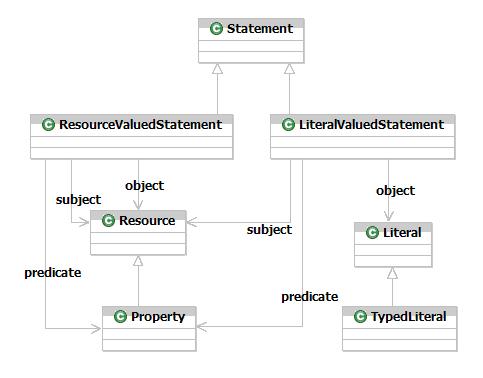Notice: This Wiki is now read only and edits are no longer possible. Please see: https://gitlab.eclipse.org/eclipsefdn/helpdesk/-/wikis/Wiki-shutdown-plan for the plan.
Difference between revisions of "One Page Intro To RDF"
| Line 1: | Line 1: | ||
For those familiar with UML, the RDF data model can be described as follows: | For those familiar with UML, the RDF data model can be described as follows: | ||
| + | [[Image:RDF_in_UML.jpg]] | ||
| + | RDF data consists of a set of (subject, predicate, object) triples called ''statements''. There are two kinds of statements: those whose object is literal value (e.g. $2.75): | ||
| − | + | :KeyLimePie, price, $2.75 | |
| − | + | and those whose object is a ''Resource'' (e.g. KeyLimePie): | |
| − | + | :PaulTrevithick, favoritePie, KeyLimePie | |
| − | + | ''Resources'' are URI references. ''Subjects'' are Resources. ''Predicates'' are a special kind of Resource called a ''Property''. | |
| − | + | ''Literals'' are text strings with optional language identifiers and optional datatype identifiers. A literal with a datatype specifier is called a ''typed literal''. Typed literals (especially when used with OWL) use most (though not quite all) of the XMLSchema types. Examples of typed literals are: "xsd:integer^^6" and "xsd:time^^06:00:00". | |
| − | + | ||
| − | Literals are text strings with optional language identifiers and optional datatype identifiers. A literal with a datatype specifier is called a typed literal. Typed literals (especially when used with OWL) use most (though not quite all) of the XMLSchema types. Examples of typed literals are: "xsd:integer^^6" and "xsd:time^^06:00:00". | + | |
Latest revision as of 10:37, 4 September 2006
For those familiar with UML, the RDF data model can be described as follows:
RDF data consists of a set of (subject, predicate, object) triples called statements. There are two kinds of statements: those whose object is literal value (e.g. $2.75):
- KeyLimePie, price, $2.75
and those whose object is a Resource (e.g. KeyLimePie):
- PaulTrevithick, favoritePie, KeyLimePie
Resources are URI references. Subjects are Resources. Predicates are a special kind of Resource called a Property.
Literals are text strings with optional language identifiers and optional datatype identifiers. A literal with a datatype specifier is called a typed literal. Typed literals (especially when used with OWL) use most (though not quite all) of the XMLSchema types. Examples of typed literals are: "xsd:integer^^6" and "xsd:time^^06:00:00".

